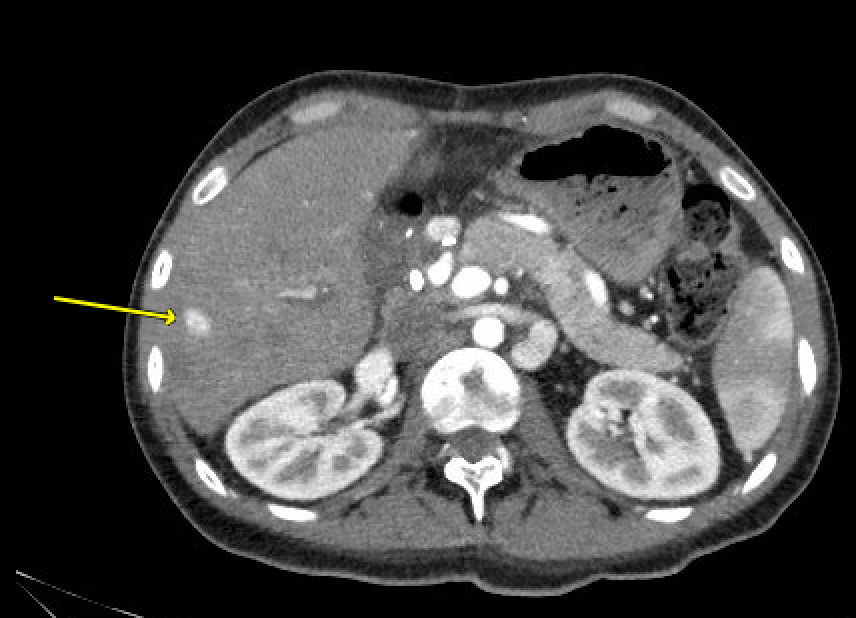Sunday Poster Session
Category: Liver
P1722 - Primary Hepatic Angiosarcoma in a Post-Transplant Liver: Diagnostic and Therapeutic Dilemmas
Sunday, October 26, 2025
3:30 PM - 7:00 PM PDT
Location: Exhibit Hall

Jose I. De Arrigunaga, DO
University of Texas Health San Antonio
San Antonio, TX
Presenting Author(s)
Jose I.. De Arrigunaga, DO1, David Twitchell, MD1, Jose Benitez, MD1, Alfredo Camero, Jr., MD2
1University of Texas Health San Antonio, San Antonio, TX; 2Gastroenterology Consultants of Laredo, Laredo, TX
Introduction: Primary hepatic angiosarcoma (PHA) is a rare and aggressive liver tumor arising from endothelial and fibroblastic cells. It accounts for approximately 2% of all primary liver tumors, making the liver the sixth most common site for primary angiosarcoma. Due to its rarity, there is currently no standardized treatment. Diagnosis is particularly challenging, as only about 9% of cases present with symptoms secondary to metastasis. We report a case involving a 30-year-old male diagnosed with PHA, who experienced rapid metastatic progression to the bone.
Case Description/
Methods: A 30-year-old male with a history of cryptogenic cirrhosis status-post liver transplant (2021) presented with bilateral hand numbness and tingling. Subsequently, he developed persistent upper shoulder pain unresponsive to steroid injections. Imaging revealed widespread metastatic disease involving the liver, calvarium, pelvis, thorax, and the cervical, thoracic, and lumbar spine. A work-up for multiple myeloma was negative. Multiple liver and bone biopsies were initially inconclusive. However, upon external pathology review, the original liver biopsy revealed “partial replacement of endothelial cells lining atrophic hepatocytes by atypical spindle cells,” consistent with angiosarcoma. CTAP (four-phase CT) revealed interval development of multiple hyper-vascular lesions in the transplanted liver with the largest measuring 2.2 cm in hepatic segment 6 (Figure 1), consistent with PHA. Additional hypo-enhancing lesions were noted, consistent with metastatic disease. The patient was started on palliative radiation, chemotherapy, and immunotherapy by Oncology. Despite treatment, the disease progressed rapidly, and the patient passed away within a year due to complications from metastatic angiosarcoma.
Discussion: Early diagnosis is important to improving outcomes in patients with angiosarcoma. However, most cases are diagnosed only after metastasis has occurred. The most effective treatment for PHA is surgical resection—but only when the disease has not metastasized. Unfortunately, chemotherapy has not showed a significant survival benefit. Even with aggressive treatment, the median survival is approximately six months with only 3% of patients surviving more than two years. Further studies are needed to improve diagnostic and therapeutic approaches for this rare but aggressive malignancy.

Figure: Figure 1. Hyper-vascular lesion measuring 2.2 cm in hepatic segment 6 suggestive of primary hepatic angiosarcoma (yellow arrow).
Disclosures:
Jose De Arrigunaga indicated no relevant financial relationships.
David Twitchell indicated no relevant financial relationships.
Jose Benitez indicated no relevant financial relationships.
Alfredo Camero, Jr. indicated no relevant financial relationships.
Jose I.. De Arrigunaga, DO1, David Twitchell, MD1, Jose Benitez, MD1, Alfredo Camero, Jr., MD2. P1722 - Primary Hepatic Angiosarcoma in a Post-Transplant Liver: Diagnostic and Therapeutic Dilemmas, ACG 2025 Annual Scientific Meeting Abstracts. Phoenix, AZ: American College of Gastroenterology.
1University of Texas Health San Antonio, San Antonio, TX; 2Gastroenterology Consultants of Laredo, Laredo, TX
Introduction: Primary hepatic angiosarcoma (PHA) is a rare and aggressive liver tumor arising from endothelial and fibroblastic cells. It accounts for approximately 2% of all primary liver tumors, making the liver the sixth most common site for primary angiosarcoma. Due to its rarity, there is currently no standardized treatment. Diagnosis is particularly challenging, as only about 9% of cases present with symptoms secondary to metastasis. We report a case involving a 30-year-old male diagnosed with PHA, who experienced rapid metastatic progression to the bone.
Case Description/
Methods: A 30-year-old male with a history of cryptogenic cirrhosis status-post liver transplant (2021) presented with bilateral hand numbness and tingling. Subsequently, he developed persistent upper shoulder pain unresponsive to steroid injections. Imaging revealed widespread metastatic disease involving the liver, calvarium, pelvis, thorax, and the cervical, thoracic, and lumbar spine. A work-up for multiple myeloma was negative. Multiple liver and bone biopsies were initially inconclusive. However, upon external pathology review, the original liver biopsy revealed “partial replacement of endothelial cells lining atrophic hepatocytes by atypical spindle cells,” consistent with angiosarcoma. CTAP (four-phase CT) revealed interval development of multiple hyper-vascular lesions in the transplanted liver with the largest measuring 2.2 cm in hepatic segment 6 (Figure 1), consistent with PHA. Additional hypo-enhancing lesions were noted, consistent with metastatic disease. The patient was started on palliative radiation, chemotherapy, and immunotherapy by Oncology. Despite treatment, the disease progressed rapidly, and the patient passed away within a year due to complications from metastatic angiosarcoma.
Discussion: Early diagnosis is important to improving outcomes in patients with angiosarcoma. However, most cases are diagnosed only after metastasis has occurred. The most effective treatment for PHA is surgical resection—but only when the disease has not metastasized. Unfortunately, chemotherapy has not showed a significant survival benefit. Even with aggressive treatment, the median survival is approximately six months with only 3% of patients surviving more than two years. Further studies are needed to improve diagnostic and therapeutic approaches for this rare but aggressive malignancy.

Figure: Figure 1. Hyper-vascular lesion measuring 2.2 cm in hepatic segment 6 suggestive of primary hepatic angiosarcoma (yellow arrow).
Disclosures:
Jose De Arrigunaga indicated no relevant financial relationships.
David Twitchell indicated no relevant financial relationships.
Jose Benitez indicated no relevant financial relationships.
Alfredo Camero, Jr. indicated no relevant financial relationships.
Jose I.. De Arrigunaga, DO1, David Twitchell, MD1, Jose Benitez, MD1, Alfredo Camero, Jr., MD2. P1722 - Primary Hepatic Angiosarcoma in a Post-Transplant Liver: Diagnostic and Therapeutic Dilemmas, ACG 2025 Annual Scientific Meeting Abstracts. Phoenix, AZ: American College of Gastroenterology.

